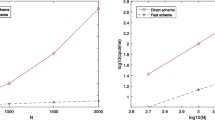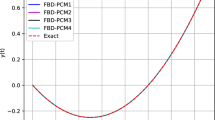Abstract
In this paper, we study the potential of fractional derivatives to model air pollution. We introduce an M-fractional truncated derivative type for \(\alpha \)-differentiable functions that generalizes other types of fractional derivatives. We denote this new differential operator by \(_{i}D_{\mathrm{M}}^{\alpha ,\beta }\), where the parameters \(\alpha \) and \(\beta \), associated with the order of the derivative are such that \(0<\alpha <1\), \(\beta >1\) and M is the notation to indicate that the function to be derived involves the truncated function of Mittag-Leffler with a parameter. The definition of this type of truncated M-fractional derivative satisfies the properties of the integer calculation. Based on this observation, we solved these models and we compared the solutions with the data obtained from the Copenhagen experiment. Fractional derivative models work much better than the traditional Gaussian model and the computed values are in good agreement with experimental ones.
Similar content being viewed by others
References
J P Bouchaud and A Georges Phys. Rep. 195 127 (1990)
R Metzler and J Klafter Phys. Rep. 339(1) 1 (2000)
R Herrmann Fractional calculus: An Introduction for Physicists (Singapore : World Scientific Publishing Company) p 528 (2011)
A A Kilbas, M Srivastava and J J Trujillo Theory and Applications of Fractional Differential Equations (Amsterdam : Elsevier) 204, p 102 (2006)
D Kai The Analysis of Fractional Differential Equations (New York : Springer) 2004, p 77 (2004)
M Caputo Elasticita e Dissipazione (Bologna : Zani-Chelli) (1969)
J Vanterler and E C Oliveira Progr. Fract. Differ. Appl. 4(4) 479 (2018)
C Oliveira and J A T Machado Math. Probl. Eng. 2014 1 (2014)
R Gorenflo and A A Kilbas, F Mainardi and S V Rogosin Mittag-Leffler Functions, Related Topics and Applications (Berlin: Springer) p 39 (2014)
R F Camargo PhD Thesis (UNICAMP, Campinas) (2009)
R Gorenflo, A A Kilbas, F Mainardi and S V Rogosin Mittag-Leffler Functions, Related Topics and Applications (Berlin : Springer) (2014)
A Giusti Nonlinear Dyn. 93(3) 1757 (2018)
M Ortigueira and J Machado Fractal Fract. 1(3) 1 (2017)
M Ortigueira and J A T Machado J. Comput. Phys. 293 4 (2015)
D Del-Castillo-Negrete Phys. Rev. E. Stat. Nonlinear Soft Matter Phys. 79 031120 (2009)
K S Miller and B Ross An Introduction to the Fractional Calculus and Fractional Differential Equations (New York : Wiley) 1, p 257 (1993)
K B Oldham and J Spanier The Fractional Calculus (New York : Academic Press) 111, p 96 (1974)
S G Samko, A A Kilbas and O I Marichev Fractional Integrals and Derivatives - Theory and Applications (Yverdon : Gordon and Beach) 1, Ch 5, Sec 24, p 457 (1993)
I Podlubny J. Fract. Calc. Appl. Anal. 5(4) 367 (2002)
M A M Ghandehari and M RanjbarKhaled Comput. Math. Appl. 65 975 (2013)
R J LeVeque Finite Difference Methods for Differential Equations (Washington : A Math) Sec 15, p 201 (2004)
B Ross A Brief History and Exposition of the Fundamental Theory of Fractional Calculus (Berlin : Frac. Calc. and its Appl.) p 5 (1975)
A G O Goulart, M J Lazo, J M S Suarez and D M Moreira Phys. A Stat. Mech. Appl. 477 9 (2017)
S M Khaled Essa, F Mubarak and A Abo Bakr World Appl. Sci. J. 34(10) 1399 (2016)
J Sabatier and C Farges J. Comput. Appl. Math. 339 30 (2018)
M D Ortigueira and F J Coito Comput. Math. Appl. 59 1782 (2010)
S P Arya Proc. Indian Natl. Sci. Acad. 69A(6) 709 (2003)
P Kumar and M Sharan Proc. R. Soc. A466 383 (2010)
Y Luchko Math. Model. Nat. Phenom. 11(3) 1 (2016)
K H Hoffmann, K Kulmus, C Essex and J Prehl Entropy 20 881 (2018)
F Mainardi Appl. Math. Lett. 9(6) 23 (1996)
G A Briggs Diffusion Estimation for Small Emissions (Tennessee : NOAA Oak Ridge) p 12 (1973)
S E Gryning and E Lyck J. Clim. Appl. Meteorol. 23 651 (1984)
W M Cox and J Tikvart Atmos. Environ. 24A(9) 2387 (1990)
M Sharan and P Kumar Atmos. Environ. 43 2268 (2009)
S E Gryning, A A M Holtslag, Atmos. Environ. 21 79 (1987)
Author information
Authors and Affiliations
Corresponding author
Additional information
Publisher's Note
Springer Nature remains neutral with regard to jurisdictional claims in published maps and institutional affiliations.
Appendices
Appendix 1: Solution of the M-Gaussian model
We start considering the so-called M-fractional linear differential equation with constant coefficients Eq.(14), here \(\lambda ^{2}\) is a positive constant. Using item 5 in Theorem, the above Equation can be written as follows:
using chain rule from point 1 of theorem part, Eq. (19) can be expressed in the form:
with \(\kappa \sim \gamma \cdot x^{\alpha }\)
whose solution is:
In the same line, the solutions \(Q_{n}(z) (n = 0, 1, 2, 3, \ldots )\) of (12) that satisfy the boundary conditions (9) with \(z_{0} = 0\) are obtained at the same time. using the equation: \(Q_{n} (z) = Q_{n} \cos (\lambda _{n}z)\) where \(\lambda _{n} = \frac{n \pi }{h}\), and assuming that \(Q_{n}\) is a constant, from the superposition principle, we arrive at the following formula:
Finally, by introducing the boundary condition (8) and using the identity
we end up at the final equation (13).
Appendix 2
We are now studying a particular case involving a fractional derivative. Choosing \(\beta = 1\) and applying the limit \(i\rightarrow 0\) on either side of Eq. (1), we have:
it is also known that
so, we conclude that
so that a trivial solution of Eq. (11) can be expressed in the form:
where \({\mathbb {E}}_{\alpha }\) represents the Mittag-Leffler function.
Rights and permissions
About this article
Cite this article
Tagne, A.S.T., Ema’a Ema’a, J.M., Ben-Bolie, G.H. et al. A new truncated M-fractional derivative for air pollutant dispersion. Indian J Phys 94, 1777–1784 (2020). https://doi.org/10.1007/s12648-019-01619-z
Received:
Accepted:
Published:
Issue Date:
DOI: https://doi.org/10.1007/s12648-019-01619-z




